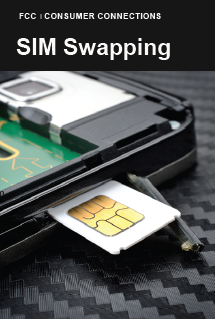Latest FCC Action
FCC Adopts Rules to Protect Consumers' Cell Phone Accounts (11/15/23)
More Consumer Information
What is a SIM card?
SIM is short for Subscriber Identity Module, a unique identifier inside every cellular device that enables wireless service providers to know the user's assigned phone number. The SIM card stores your personal data and may be removable, depending on the device.
SIM card technology has evolved over time, resulting in smaller sized micro- and nano-sized cards that created more space in the mobile phone for manufacturers to increase battery sizes or add other features. In an effort to minimize the space occupied by SIM cards, eSIMs were developed.
What is an eSIM card?
The “e” in eSIM means embedded. An eSIM card is hardwired into the phone itself. Because of its advantages, eSIM cards are replacing nano cards in newer cell phone models.
Is it possible that my phone has both SIM and eSIM cards?
Some cell phones may have both a removable SIM card and an eSIM card, which allows customers to have two separate numbers – such as a personal number and a work number – on one device. The dual SIM feature is supported on a wide range of mobile phones and many wireless providers are currently offering it.
Does having an eSIM card improve my data security?
Yes, there are significant security benefits. An eSIM card cannot be stolen without stealing the phone, whereas removable SIM cards are sometimes stolen, and used in port out scams. That's when identity thieves fraudulently swap stolen SIM cards into different phones to gain access to the victim’s calls and text messages. The thieves may then try to reset credentials and gain access to the victim's financial and social media accounts.
For more information about SIM swapping, port out scams, cell phone cloning and subscriber fraud, see our consumer guide on cell phone fraud.
What should consumers know when replacing or upgrading a cell phone?
When it's time to replace your cell phone or upgrade to a new model, check your old phone to find out if it has a physical SIM card, uses an eSIM, or both. If the device you are replacing uses an eSIM, wipe all data from the eSIM card before you dispose of or recycle the device. Check with the manufacturer and your service provider for instructions on how to properly wipe the data. If your old phone had a physical SIM card, you should remove it. You can either store it securely as a backup or destroy it so there’s no risk of having the data on it stolen.
What are some other advantages of eSIM cards?
- It's easier to change service providers and keep the same phone. Consumers with unlocked devices who want to change providers no longer need to physically change their SIM card. Instead, eSIM cards can be reprogrammed through the device settings to work with a new provider.
- When travelling internationally, instead of replacing their SIM card with one from a local provider, a consumer can select from available options for the country or countries they plan to visit, a feature enabled by their phone’s eSIM capabilities, in some cases through a drop-down menu in their phone settings. Some phone manufacturers offer instructions on how to use plans from two different providers when using an eSIM and a traditional SIM card. Check out more FCC consumer tips for using your cell phone on international travel.
- Removing or replacing physical SIM cards requires a small tool or paperclip to unlock the compartment that holds the card inside the phone. With eSIM, there’s no need to access a physical card, so no tools are required.
Printable Version
eSIM Cards FAQ (pdf)
Alternate Format Requests
People with print disabilities may request braille, large print, or screen-reader friendly versions of this article via the email form at fcc504@fcc.gov. For audio and other access, use the "Explore Accessibility Options" link.
Consumer Help Center
Learn about consumer issues - visit the FCC's Consumer Help Center at fcc.gov/consumers
File a Complaint with the FCC
Visit our Consumer Complaint Center at consumercomplaints.fcc.gov to file a complaint or tell us your story.
